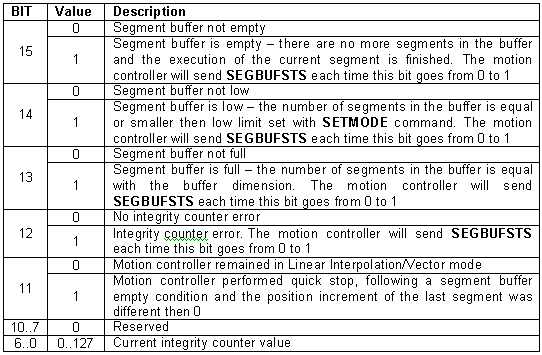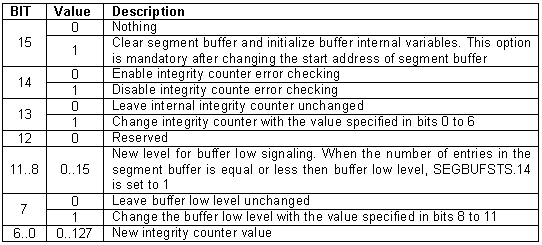Parameters
| MASTERID | Contains the axis ID of the host/master where the motion controller must send the messages related to segment buffer. It must be set before starting the Linear Interpolation mode. The MASTERID value must be set as: host ID << 4 + 1, where host ID is a number between 1 and 255 representing the host ID. By default, after power-on the host ID is set equal with the drive address causing all the messages to be sent via RS-232 |
| SEGBUFBEGIN | Specifies the start address of the segment buffer |
| SEGBUFLEN | Specifies the segment buffer length expressed in segments |
RESRATIOX, RESRATIOY, RESRATIONZ Defines the position feedback resolution for each axis. The motion controller will use the best resolution for computing the segments in PVT points.
VSPD – vector speed for current segment. Measured in speed units
VACC – vector acceleration for current segment. Measured in acceleration units
Variables
SEGBUFSTS Contains the status of segment buffer.
SEGBUFSTS bit description

| MACOMMAND | Linear Interpolation operation mode as was set with the SETMODE command |
| VTPOS | Vector target load position – position reference computed by the reference generator at each slow loop sampling period. Measured in position units |
Instructions
SETMODE value Set Linear Interpolation operation as specified by value:
Linear Interpolation operation mode (a copy of value is saved in the TML variable MACOMMAND)

LPLANE (X_axis, Y_axis, Z_axis) Set the coordinate system for 2D/3D move.
MODE LI Set Linear Interpolation motion mode.
LPOS1 (X_inc, Y_inc, Z_inc) LPOS2 (X_inc, Y_inc, Z_inc) Describes a linear segment.
UPD Update motion parameters and start new motion mode
STOP Stop the motion
Remarks:
| • | When a sequence of segments is executed from a TML program they are processed one after the other, until the segment buffer fills up. At this point the TML program stops until the buffer starts to empty. Therefore, the next segment is processed in the cadence of the segments execution. At the end of the sequence, the buffer starts to empty and next TML instructions start to execute. This may lead to incorrect operation if for example a new motion mode is set while there are still segments in the buffer waiting to be executed. In order to avoid this situation, it is mandatory to end the segments sequence with an event on motion complete and wait until this event occurs. |
| • | The motion complete event is set when all the slave axes signal the end of their movement. |
Programming Example
// Linear Interpolation sequence executed from non-volatile
// memory of the drive. All slave execute a linear movement and
// have the feedback resolution identical (2000 counts/rev)
SETMODE 0xCF00; //Clear buffer
LPLANE (A, B, D); //Axes A, B and D define the coordinate
//system of the movement
RESRATIOX=0u; // All axes have the same feedback resolution
RESRATIOY=0u; // therefore the resolution ratio is 0
RESRATIOZ=0u;
MODE LI; // Set Linear Interpolation Mode
VACC = 0.0002; // Vector Acceleration = 0.5[m/s^2]
VSPD = 1.2732; // Vector Speed = 4[m/s]
// Increment position with (X, Y, Z) = (1e+002[mm], 3e+001[mm], 3e+001[mm])
LPOS1 32L, 10L, 11L; LPOS2 32L, 10L, 11L;
UPD; //Execute immediate
// Increment position with (X, Y, Z) = (3e+001[mm], 3e+001[mm], 1e+002[mm])
LPOS1 10L, 8L, 32L; LPOS2 10L, 8L, 32L;
// Insert End Segment
LPOS1 0L, 0L, 0L; LPOS2 0L, 0L, 0L;
See also: